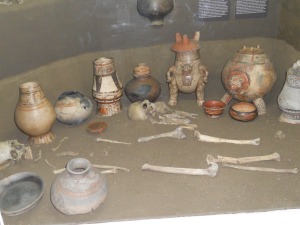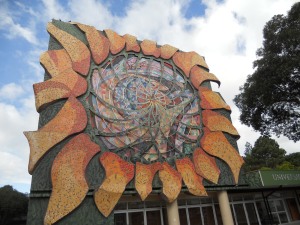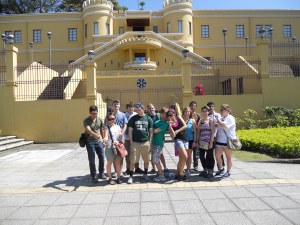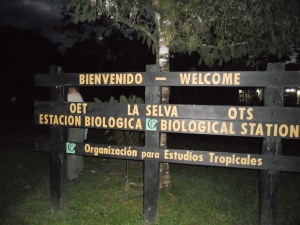San Jose – History/Culture – Social/Cultural issues in engineering – Anh
15 December 2012
Hola! It is the first day of our trip and several of us have arrived earlier. One aspect of Costa Rica that I have noticed is how flamboyant their artwork is. Much of the art in Central America and the Caribbean is derived from Spanish style. Much of it consists of elaborate detail. This was displayed throughout the walls of the Adventure Inn Hotel, the first night of our accomadations. The Adventure Inn Hotel is a convinient place to stay since it is about ten to fifteen minutes away from the San Jose International airport. It also provides a free shuttle, which was benevolent for those of us who traveled on our own. The Adventure Inn also arranges guided tours throughout Costa Rica. Guests who stay here will be able to see waterfalls, mountains, and zip-line!
For extra leisure time and convinience purposes, several of us including Luke, Ben, Alex, Robbie, Katie, and myself arrived in the country one day early. The boys have arrived earlier than Katie and I, and have spent the night in a hostile in San Jose. Therefore, we all met up at Adventure Inn and traveled to the Estacion Experimental Fabio Baudrit Moreno (Fabio Agricultural Station) in Alajuela, Costa Rica. This extension of Universidad de Costa Rica, which was founded in 1955, is used to conduct research in the agricultural sector and contribute conservation of the environment and improve the quality of life in Costa Rica. Students who are at their final year of study gain practical experience in agronomic fields from this station. The station is about 53.6 hectares is is location at an elevation of 840 meters!
When we arrived, there was a soccer game among Costa Rican students on the field. Soccer is one of the most commonly played sports in Costa Rica. Robbie yelped out in ecstasy and sprinted to join them during their game. Meanwhile, the rest of us American students decided to hike around and explore the station. We encountered several trails of leaf-cutting ants, and a lot of different plant species.
When we returned, we socialized with many Costa Rican agricultural engineering students at UCR as we enjoyed a typical Costa Rican lunch. This included a small salad, plantain made from bananas, and rice & beans. We enjoyed maracuya, which is a drink squeezed from passion fruit. After, lunch, we toured developing research facilities at the station with the Costa Rican students and faculty. These new facilities will involve labwork for bioenergy systems. We also visited the wetland and anaerobic digestion sites (see days 12 & 13).
Shortly afterwards, we reunited with the rest of the group. We then proceeded to listen to the presentations (see days 0 & 1). Afterwards, we returned to the hotel rested in deep slumber for the following day.
16 December 2012
We began our first morning in Costa Rica by waking up and having breakfast at the Adventure Inn Hotel. The hotel provided many scrumptious breakfast dishes on their menu, including rice and beans, which is the staple of the Costa Rican diet. After leaving the hotel, we made our way to our first destination which was the Museo Nacional De Costa Rica (The National Museum) .
This attraction consists of many extravagant exhibitions including a butterfly dome, a Precolombian hall of artifacts, “Spirits of Haiti” that show images and promote prayer from the catastrophic 2010 Earthquake, a “House of Commanders” which displays architecture of early San Jose, and much more. The museum was opened in in 1887 by President Benardo Soto. The intentions were to promote scientific research and study history and artificats.
The entrance of this museum was the butterfly dome where butteflies native to Costa Rica flutterd aroun. This area highlights the life cycle of a butterfly and general facts about their biology. Since we are in the tropics, plant biodiversity is generally high. This area also consists of many plants that butterflies feed on.
The majority of the museum highlights Costa Rica’s transition from the hunting-gathering phase to agricultural practices. This was a time when inhabitants began to discover the growth of crops and understand their origins.There were also many displays that consists of tools used during this time period, including motars. This portrays the beginning of engineering tools to satisfy human needs.
Some other important cultural aspects the museum highlights how some belief systems of the people influence their practices in agriculture. They mainly discourage overuse of natural resources. For example, the animalist belief system states that all beings of nature exhibits some kind of supernatural power. Earlier Costa Rican cultures during the pre-Colombian times believe that manmade objects have a soul. Many of these beliefs are integrated into religion and social political systems.
Many harvesting methods in certain agricultural fields, including the banana and coffee plantations, rely on handpicking to collect their crops. For instance, other countries in Latin America have made advances in technology to collect coffee beans more efficiently using a mechanical harvester that shakes the beans off its branches. Though this may yield more output and reduce the amount of time taken for this task, there would be less jobs for plantation workers.

Display of early pottery created during pre-Colombian times. Bones might be remains of early settlers.
The next thing on our agenda was ambling down the streets of San Jose to eat lunch at the Rosti Pollos. Again, we continue to order and indulge in Native Costa Rican dishes. We then briefly explored the gifts shops prior to heading to the Universidad de Costa Rica (UCR). Walking through the busy streets of Costa Rica gave us an insight of the different vendors, including different merchandise that is sold. It also stimulated our wariness and reminded us to not wander alone.
One we arrived at UCR, our fellow Costa Rican companions whom we have been traveling with gave us a brief tour of their university . This institution was established during the 1940. The university specializes and teaching, research, social action, and artistic creation. Health and engineering are the top academic programs of this university.We then noticed the abundance of bamboo in several areas, which later helped us brainstorm for our wetlands design group project.

Sunflower Mosaic on a building at UCR. This is the logo of the university and is a common form of Costa Rican art.
After this, we then headed out to our next destination which was Organization of Tropical Studies (OTS) Biological Station via bus. On this bus ride, there was a lot of interaction and exchanging of stories between American and Costa Rican students. One of the directors of UCR also provided explanations of certain landforms such as the cloud forest and vegetation such as “umbrella” leaves during our ride.
OTS is a field research station and non-profit consortium of more than 60 universities, colleges, and research institutions from Various countries in North America, Central America, South America, South Africa, and Australia. Policy training for natural resource managers in Latin America is provided here. Much of the research at OTS focuses on how the ecology of tropical systems has changed due to global climate change. This includes nutrient cycling, carbon cycling, water cycling, biomass productivity, disease spread, conservation, and many other ecological aspects.
Once we arrived at OTS, we settled into our cabins, ate dinner, and then debriefed and reflected on our day as a group. This set us up to work on our floating mat wetlands project. We split up into three groups where each consisted of both Costa Rican and American students to collaborate to build a floating mat wetland that can perform efficient phytoremediation services.
After each group finished brainstorming their tentative ideas for building the floating mat, we retired for the day. Costa Rican and American students mixed and mingled in socializing and games.
Related Links
Adventure Inn Hotel: http://www.adventure-inn.com/description/
Estacion Experimental Fabio Baudrit Moreno: http://www.eefb.ucr.ac.cr/
General Costa Rica economic background: http://www.economists.com/topics/costa―rica
Museo Nacional De Costa Rica: http://www.museocostarica.go.cr
Organization of Tropical Studies (OTS): http://www.ots.ac.cr/
Universidad De Costa Rica Agricultural Engineering Program: http://www.ingagri.ucr.ac.cr
Universidad De Costa Rica: http://www.ucr.ac.cr





December 19, 2012 at 4:44 pm
What are some cultural and social differences between Costa Rica and the U.S. that you think will affect engineering?
December 21, 2012 at 2:42 am
One example is that Costa Rica, unlike the United States consists of different types of fruits that generate waste, especially pineapple. Engineers can figure out how to reduce and utilize this food waste in their practices. Certain religions, such as the ones described above may promote or discourage certain practices based on an individuals belief. In the US, economic recession is a vital issue and will encourage augment and growth of engineering fields.
December 21, 2012 at 8:01 pm
Every crop generates waste: the peels of oranges, the cores of apples, the stalks of corn, etc. We have to deal with waste in the US too. What are some ways that engineers and farmers can beneficially use this waste?
December 29, 2012 at 1:13 am
The waste can be put in a container to decompose and used as organic fertiliser for crops; decompose is generally rich in nutrients. Some of this food waste can also serve as animal feed.
Engineers can use this waste as food for the microbes in anaerobic digesters as an input.
December 21, 2012 at 12:06 am
I compeletly agree with your connection between the tools displayed at the museum and how that was an early example of engineering intuition. I thought starting the trip off with the museum gave a nice introduction to early agricultural methods and how basic human procedures have changed through the times.
December 22, 2012 at 1:27 am
In response to what can be done to the waste which is generated by the crops themselves, it was so interesting how everything is either used up or all reused. By reused I mean that the waste is given a new purpose. Through anaerobic respiration the fermentation of biological waste materials is accomplished. In the case of the fermentation containers that we were able to visit, the partly decomposed plant parts of the molasses were used as a pilot experiment by Corbana. Corbana hopes to use this fermented mixture as a biofertilizer or biopesticides. This means that if this experiment is successful, Costa Rica will be able to cut down its pesticide use by 50% by 2015!
December 27, 2012 at 8:03 pm
Now that we have seen all bananas, rice, and coffee, do you think Costa Rica will able to reach its goals of reducing carbon footprint? I feel they are using very constructive methods to accomplish their objective. I feel bad because before this trip I was naive about the cultural and agricultural actions.